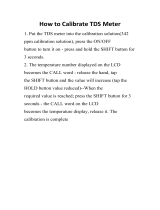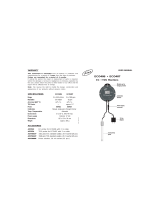Page is loading ...

SPECIFICATIONS
Range pH 0.00 to 14.00
EC 0 to 3999 µS/cm
TDS 0 to 2000 ppm
Temperature 0.0 to 60.0°C or 32.0 to 140.0°F
Resolution pH 0.01pH
EC 1 µS/cm
TDS 1 ppm
Temperature 0.1°C or 0.1°F
Accuracy pH ±0.01pH
(@20°C/68°F) EC/TDS ±2% F.S.
Temperature ±0.5°C or ±1°F
Typical EMC pH ±0.03pH
Deviation EC/TDS ±2% F.S.
Temperature ±0.5°C or ±1°F
Temperature pH Automatic
Compensation EC/TDS ß = 0.0 to 2.4%/°C
pH Calibration 1 or 2 point with auto-buffer recognition
4.01/7.01/10.01 pH or 4.01/6.86/9.18 pH
EC/TDS Calibration Automatic (25°C/77°F) 1 point at:
1413µS/cm, 1382 ppm (0.5 conv.), 1500 ppm (0.7 conv.)
Conductivity to TDS 0.45 to 1.00 (CONV)
Conversion Factor
Probe HI 1288 pH/EC/TDS/temp. probe (included)
Battery Type/Life 4 x 1.5V AAA with BEPS / 500 hours
Environment 0 to 50°C (32 to 122°F); RH 100%
Dimensions 143x80x38mm (5.6x3.2x1.5”)
OPERATIONAL GUIDE
To connect the probe
Connect the HI 1288 probe to the DIN socket on the top of
the meter by aligning the pins and pushing in the plug.
Tighten the nut to ensure a good connection. Remove the
protective cap from the HI1288 probe before taking any
measurement.
To turn the meter on and to check battery status
Press and hold the ON/OFF/MODE button for 2 seconds.
All the used segments on the LCD will be visible for a few
seconds, followed by a percent indication of the remaining
battery life. Eg. % 100
BATT.
To select the measurement unit (pH or EC or TDS)
Press the SET/HOLD button while in normal measurement
mode. The meter will display pH or EC or TDS.Temperature
will always be displayed on the bottom. Eg. pH 5.73 22.5 °C.
To freeze the display
Press and hold the SET/HOLD button until HOLD appears
on the secondary display. Eg. pH 5.73 hold.
Press either button to return to normal mode.
To turn the meter off
Press and hold the ON/OFF/MODE button while in normal
measurement mode. OFF will appear on the lower part of
the display. Release the button.
HI 991300 Instruction Manual
Portable pH/EC/TDS/Temperature Meter
Eg. TEMP °C.
Use the SET/HOLD button to change the temperature unit,
and then press the MODE button three times, until the meter
returns to normal measurement mode.
To reset to the default calibration
To clear a previous calibration, press the MODE button af-
ter entering the calibration mode. The lower LCD will dis-
play ESC for 1 second and the meter will return to normal
measurement mode. The “CAL” symbol on the LCD will
disappear. The meter will be reset to the default calibration.
Battery replacement
The meter displays the remaining battery percentage every
time it is turned on. When the battery level is below 5%, the
- +
symbol on the bottom left of the LCD lights up to indi-
cate a low battery condition. If the battery level is so low as
to cause erroneous reading, the Battery Error Prevention
System (BEPS) will automatically turn the meter off.
To change the batteries, remove the 4 screws located on
the back of the meter. Once the back has been removed,
carefully replace the 4 AAA batteries located in the compart-
ment while paying attention to their polarity. Replace the
back, making sure that the gasket is properly seated in
place, and tighten the screws.
Calibration solutions
HI 77400P pH 4.01 & 7.01 solutions, 20 mL sachets (5 each)
HI 770710P
pH 7.01 & 10.01 solutions, 20 mL sachets (5 each)
HI 70004P pH 4.01 solution, 20 mL sachet (25 pcs)
HI 70006P pH 6.86 solution, 20 mL sachet (25 pcs)
HI 70007P pH 7.01 solution, 20 mL sachet (25 pcs)
HI 70009P pH 9.18 solution, 20 mL sachet (25 pcs)
HI 70010P pH 10.01 solution, 20 mL sachet (25 pcs)
HI 77100P pH 7.01 & 1413 µS/cm @25°C (20 mL, 10 pcs each)
HI 77200P pH 7.01 & 1500ppm @25°C (20 mL, 10 pcs each)
HI 77300P pH 7.01 & 1382 ppm @25°C (20 mL, 10 pcs each)
HI 70031P 1413 µS/cm @25°C solution, 20 mL sachet (25 pcs)
HI 70442P 1500 ppm @25°C solution, 20 mL sachet (25 pcs)
HI 70032P 1382 ppm @25°C solution, 20 mL sachet (25 pcs)
Other accessories
HI 710007 Protective rubber boot
HI991300 is in compliance with the CE directives.
IS991300R3 11/00
www.hannainst.com

pH MEASUREMENTS & CALIBRATION
• Before taking any measurement make sure the meter
has been calibrated.
• If the probe has been left dry, soak in a storage or pH 7
solution at least for one hour to reactivate it.
• Select the pH mode with the SET/HOLD button.
• Submerge the probe in the sample to be tested while
stirring it gently. Wait until the stability symbol on the
top left of the LCD disappears.
• The pH value automatically compensated for temperature
is shown on the primary LCD while the secondary LCD
shows the temperature of the sample.
• If measurements are taken in different samples succes-
sively, rinse the probe tip thoroughly to eliminate cross-
contamination; and after cleaning, rinse the probe tip with
some of the sample to be measured.
Calibration buffer set
• While in pH measurement mode, press and hold the
MODE button until TEMP and the current temperature unit
are displayed on the lower LCD. Eg. TEMP °C.
• Press the MODE button again to show the current buffer
set: pH 7.01 BUFF (for 4.01/7.01/10.01) or pH 6.86 BUFF (for
4.01/6.86/9.18).
• Press the SET/HOLD button to change the buffer set.
• Press the MODE button to return to normal pH measure-
ment mode.
pH calibration
• While in pH measurement mode, press and hold the
MODE button until CAL is displayed on the lower LCD.
• Release the button. The LCD will display
pH 7.01 USE or pH
6.86 USE (if you have selected the NIST buffer set).
• For a single point pH calibration, place the probe in any
buffer from the selected buffer set (eg. pH 4.01 or pH 7.01
or pH 10.01). The meter will automatically recognize the
buffer value.
If using pH 7.01 (or 6.86 from the NIST buffer set), after
recognition of the buffer press the MODE button to return
to the pH measurement mode.
• For a two point pH calibration, place the probe in pH 7.01
(or 6.86, if you have selected the NIST buffer set). The
meter will recognize the buffer value and then display pH
4.01 USE.
Place the probe in the second buffer (pH 4.01 or 10.01,
or, if using NIST, pH 4.01 or 9.18). When the second buffer
is recognized, the LCD will display OK for 1 second and
the meter will return to normal measurement mode.
EC/TDS MEASUREMENTS & CALIBRATION
• Place the probe in the sample to be tested. Use plastic
beakers or containers to minimize any electromagnetic
interference.
• Select either EC or TDS mode with the SET/HOLD but-
ton.
• Tap the probe lightly on the bottom of the container to re-
move air bubbles that may be trapped inside the tip.
• Wait for a few minutes for the temperature sensor to reach
thermal equilibirium (i.e. until the stability symbol on
the top left of the LCD disappears).
• The meter will show the EC/TDS value automatically com-
pensated for temperature and the temperature of the
sample.
To change the EC/TDS conversion factor (CONV) and
the EC/TDS temperature compensation (BETA)
• While in EC/TDS measurement mode, press and hold
the MODE button until TEMP and the current temperature
unit are displayed on the lower LCD. Eg. TEMP
°C.
• Press the MODE button again to show the current con-
version factor. Eg. 0.50 CONV.
• Press the SET/HOLD button to change the conversion
factor.
• Press the MODE button to show the current temperature
compensation ß. Eg. 2.1 BETA.
• Press the SET/HOLD button to change the temperature
compensation ß.
• Press the MODE button return to normal operation.
EC calibration
• While in the EC measurement mode, press and hold the
MODE button until CAL is displayed on the lower LCD.
• Release the button and immerse the probe in HI7031
calibration solution (µS 1413 USE).
• Once the calibration has been automatically performed,
the LCD will display OK for 1 second and return to normal
measurement mode.
• Since there is a known relationship between the EC and
TDS reading, it is not necessary to calibrate the meter in
TDS. If the EC/TDS conversion factor is either 0.5 or 0.7,
the meter will allow a direct calibration in ppm by using
the Hanna calibration solutions listed below.
TO CHANGE THE TEMPERATURE UNIT (FROM °C TO °F)
Press and hold the MODE button until TEMP and the cur-
rent temperature unit are displayed on the secondary LCD.
ppm ppt µS pH
ATC
%
CAL
- +
°C
°F
Primary
display
Secondary
display
Selectable
temperature
unit
Stabilty
indicator
Battery
percentage
Low battery
indicator
/


